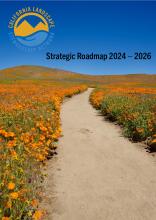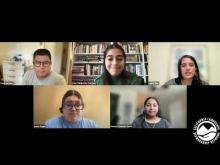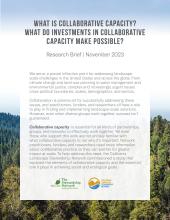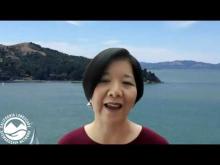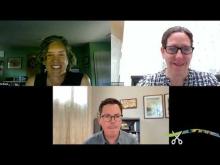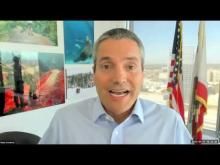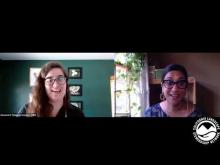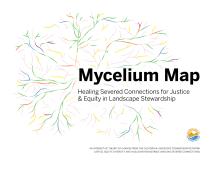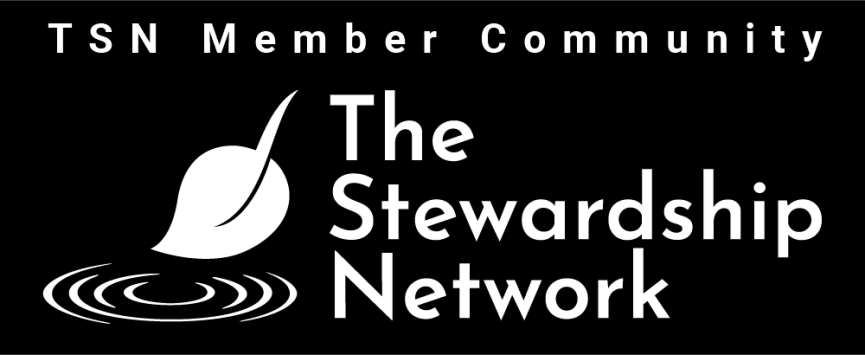From changing foundational systems to supporting individuals working on the ground, find out what the CLSN has been doing to increase the pace and scale of collaborative stewardship.
California Landscape Stewardship Network, June 2024
From 2024–2026, CLSN will connect practitioners, tackle systemic barriers, and promote equitable landscape stewardship across California.
- Details
Enter resource descrFrom 2024 to 2026, the CLSN will focus its efforts on the three areas. These multi-faceted, interrelated, and emergent topics build upon our strengths while allowing us to continue to be nimble and adaptive to opportunities and needs that arise from our community of practice.
- Connecting collaborative practitioners in ways that inform, equip, and empower;
- Advancing solutions to systemic barriers that limit collaborative stewardship action;
- Supporting the landscape stewardship movement that leads with equity, justice, and inclusion
Specific objectives and activities under each focal area are detailed in this report.iption/details here.
California Landscape Stewardship Network, March 2023
Details a regulatory shift to streamline environmental restoration, highlighting the Cutting Green Tape initiative’s impact.
- Details
-
A paradigm shift is inherently complex and difficult to achieve. It is particularly challenging within a layered, multiagency regulatory environment that has been built over decades. However, it can be done. This case study examines one promising example—Cutting Green Tape (CGT)—that not only aims to increase regulatory and permitting efficiencies, but also to shift our collective thinking about how multibenefit environmental restoration projects in California can happen.
The CGT case study allows us to explore the evolution and current status of a perceived paradigm shift. This case study’s researchoriented lens and consideration of Kuhn’s seminal work on shifting paradigms (1970) reveals CGT’s progression in a way that can be applied by a wide range of professional audiences. Insights are shared with those seeking to create such a shift within regulatory (or similar) contexts.
Findings indicate that a paradigm shift for environmental restoration work in California is indeed underway. CGT is moving into the final phase of a five-phase process (see Five Phases of a Paradigm Shift). Two of the four signs of a true paradigm shift (see Four Signs of a Paradigm Shift) have been fulfilled, and there are initial indicators of progress towards the third sign of change as well. However, while promising, CGT as a new paradigm (i.e., a profound change in approach or underlying assumptions) has yet to be fully realized.
California Landscape Stewardship Network, August 2023
- Details
On August 10, 2023, we were joined by four rising leaders in California to continue highlighting efforts statewide that center equity, justice, Tribal sovereignty, and inclusion in the stewardship of land, water, and communities:
- Barbara Camacho Garcia, Grassroots Ecology
- Benjamin Chang, California Climate Action Corps
- Ivette Torres, The People's Collective for Environmental Justice
- Irene Takako Farr, Better World Group
This series is hosted by the CLSN’s Justice, Equity, Diversity, & Inclusion Roundtable for Healing Severed Connections. This lunchtime conversation was moderated by JEDI Roundtable member Laurel Wee.
November 2023
Explores how collaborative capacity enables diverse groups to address landscape-scale challenges like climate change and water management effectively.
- Details
-
We are at a pivotal inflection point for addressing landscape scale challenges in the United States and across the globe. From climate change and land-use planning to water management and environmental justice, complex and increasingly urgent issues cross political boundaries, scales, demographics, and sectors. Collaboration is paramount for successfully addressing these issues, and practitioners, funders, and researchers all have a role to play in finding and implementing landscape-scale solutions. However, even when diverse groups work together, success isn’t guaranteed.
Collaborative capacity is essential for all kinds of partnerships, groups, and networks to effectively work together. Yet even those who support this work are not entirely familiar with what collaborative capacity is, nor why it’s important. Network practitioners, funders, and researchers need more information about collaborative practice so they can partner for greater impact at scale. To help address this need, the California Landscape Stewardship Network commissioned a study that explored the elements of collaborative capacity and the essential role it plays in achieving social and ecological goals.
November 2023
Explores how investing in collaborative capacity strengthens conservation outcomes and fills governance gaps through inclusive action.
- Details
-
Collaborative conservation and stewardship offer effective approaches for addressing complex challenges such as climate change, biodiversity loss, and environmental justice. They also provide innovative ways to fill governance gaps and make inclusive decisions in situations for which we have no sufficient structure, processes, or abilities. However, in order to effectively allocate scarce resources, we need to better understand how to invest in the “collaborative capacity” that sustains collaborative groups, partnerships, and networks.
This study provides an analysis of what collaborative capacity is and how it leads to improved conservation and stewardship outcomes based on expert perspectives gathered from in-depth interviews and focus groups with practitioners, leaders, and funders across the United States.
We present a framework that illustrates the collaborative capacity elements that are necessary and fundable, as well as a list of activities they enable. We share the reasons why consistent, long-term investment in these elements is needed. We emphasize the contextual factors that affect collaboration so that these investments are made in the right places, at the right times, and in the right ways to achieve their potential. We end with a set of recommendations directed toward practitioners, funders, and researchers that will help align their efforts, making them more effective, efficient, and able to achieve durable outcomes.
California Landscape Stewardship Network, May 2022
- Details
-
On May 19, 2022, Katherine Toy, Deputy Secretary for Access at California Natural Resources Agency, joined the network for the kickoff of a multi-part series sponsored by the CLSN's Justice, Equity, Diversity & Inclusion Roundtable for Healing Severed Connections. In a conversation moderated by Kindley Lawlor and hosted by Yakuta Poonawalla, Katherine offers her perspectives on why increasing access to natural and cultural sites in California is so important.
California Landscape Stewardship Network, September 2022
- Details
-
On September 7, 2022, the California Landscape Stewardship Network hosted the 5th virtual Cutting Green Tape Exchange. During two hours, we heard insights, updates and more on the Cutting Green Initiative from:
- Welcome from lead facilitator Shawn Johnson (University of Montana)
- Reflections on Cutting Green Tape from Wade Crowfoot (California's Secretary for Natural Resources)
- Presenting the Hidden Hero Awards to Madeline Cavalieri (California Coastal Commission) and Jake Shannon (North Coast Regional Water Board)
- SERP Program highlights and updates from Brad Henderson (California Department of Fish and Wildlife)
- Practitioners' panel on SERP Program project implementation including Kristan Culbert (American Rivers), Kellyx Nelson (California Landscape Stewardship Network), and Jim Robins (San Mateo RCD)
- News Announcement on the Programmatic USFWS Biological Opinion from Katie Haldeman (Sustainable Conservation) and Lee Ann Carranza (US Fish & Wildlife Service)
- Discussing the Cutting Green Tape Case Study with Amy Mickel (California State University at Sacramento) and Sharon Farrell (California Landscape Stewardship Network)
- Closing Reflections from Jennifer Norris (Deputy Secretary for Biodiversity and Habitat) The Exchange was facilitated by Shawn Johnson, CLSN Steering Committee member and Director at the University of Montana's Center for Natural Resources & Environmental Policy.
California Landscape Stewardship Network , March 2022
- Details
-
On March 17, 2022, restoration practitioners from across the state joined the 4th virtual Cutting Green Tape Exchange, hosted by the California Landscape Stewardship Network in partnership with California Natural Resources Agency. With a mix of live and pre-recorded sessions, we heard from a great cast of individuals increasing the pace and scale of beneficial environmental restoration, including:
Reflections and Progress Made on Cutting Green Tape by Wade Crowfoot, California Secretary for Natural Resources
Implementing Cutting Green Tape through CA Department of Fish & Wildlife by Jennifer Norris, Deputy Secretary for Biodiversity & Habitat
Highlighting Efficiencies in Permitting from CDFW's Cutting Green Tape Program by Brad Henderson, California Department of Fish & Wildlife
Updates on Cutting Green Tape in the Coastal Zone by Madeline Cavalieri, California Coastal Commission
Updates on Cutting Green Tape from SWRCB by Phil Crader, State Water Resources Control Board
Interviews on Interagency Efforts to Cut Green Tape by Amy Hutzel, California Coastal Conservancy Jim Robins, Integrated Watershed Restoration Program Kim Caringer, Tahoe Regional Planning Agency
Interviews on Indigenous Stewardship & Cutting Green Tape by Victor Bjelacac, California State Parks Don Hankins, CSU Chico & Indigenous Stewardship Project
The event was facilitated by Shawn Johnson, Managing Director at the University of Montana's Center for Natural Resources & Environmental Policy.
California Landscape Stewardship Network, June 2022
- Details
-
On June 29, 2022, the CLSN continued its Equity Leaders Speaker Series with a visit from Geneva E.B. Thompson, Assistant Secretary for Tribal Affairs.
California Landscape Stewardship Network, June 2022
Explores relationships and disconnections in stewardship networks to support equity and systemic healing.
- Details
-
The Mycelium Map was first created for the Stewardship.2021 Spring Forum – a convening of the California Landscape Stewardship Network – to bring Justice, Equity, Diversity, and Inclusion (JEDI) principles into all scales of participation in the Spring Forum, from the individual, organizational, network, and beyond. Going beyond that point in time, the co-creators intend for the Mycelium Map to drive conversation, lead action, and increase connectivity across our field of practice, from regional, state, national, and international levels.


